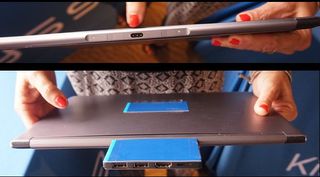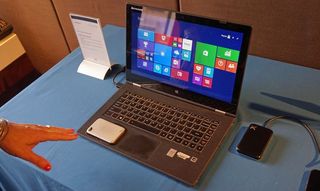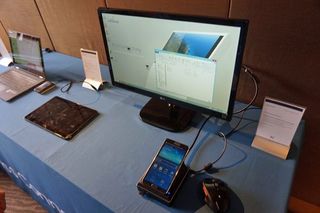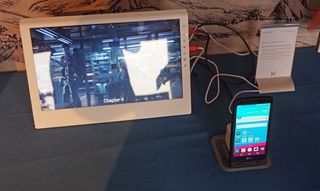Contactless 'Kiss' Connector is Like NFC on Steroids
The PC industry is just starting to embrace USB Type-C and Thunderbolt 3, but one company wants us to move beyond wires and ports already. Keyssa's "Kiss" connector provides up to 6 Gbps of wireless data transfer when you place one connected device directly on top of another.
Though the 7-year-old California-based company has been demonstrating its technology at trade shows for a couple of years now, it unveiled its first partnerships with accessory makers at last week's Computex event. Four companies -- Fresco Logic, Pcase, Phison and Sure-Fire -- announced plans to develop aftermarket products based on Kiss in the near future.
I had a chance to see a number of Kiss demos in action at Keyssa's booth in Taipei and came away impressed with the contactless connection's speed and simplicity. With Kiss, there are no jacks or ports to wear out from repeated connecting and disconnecting. However, unlike traditional wireless technologies such as WiGig or Wi-Fi direct, the two gadgets have to be physically touching so there's little chance for hackers to intercept the data or interference to prevent a solid connection. It also doesn't require special software to activate.
Kiss reminds me a lot of NFC (Near Field Communications), but with extraordinarily fast speeds. While NFC can't really be used for data transfer as it tops out at a glacial 424 Kbps, Kiss is quicker than USB 3.0.
Acer's Aspire Switch 12 S is the first shipping product that uses Kiss technology, but you wouldn't be able to tell by using it. Keyssa's connectors transfer the data between the tablet and keyboard dock on this 2-in-1, but they just work behind the scenes like the proprietary connectors on similar devices such as the Surface. Whether users are typing on the keyboard or copying files from an external hard drive that's attached to the Switch 12 S's USB port, all that data is moving over Kiss.
MORE: Best 2-in-1s (Laptop/Tablet Hybrids)
At its Computex suite, Keyssa also showed off a super-thin prototype laptop that had no physical ports, just a single Kiss connector on the back. The prototype measured just 0.35 inches, which makes it significantly thinner than the MacBook (0.52 inches) or the Asus ZenBook 3 (0.47 inches). A port replicator with full-size HDMI and USB ports attached to the Kiss connector and was held in place by magnets. Though Kiss doesn't do power delivery, a manufacturer could also send power over the connection.
Stay in the know with Laptop Mag
Get our in-depth reviews, helpful tips, great deals, and the biggest news stories delivered to your inbox.

Keyssa also demonstrated how quickly Kiss can transfer files from an external storage device. When a company rep placed an external SSD on the deck of a Keyssa-enabled laptop, the drive appeared in Windows Explorer; she could then copy a full-length HD movie in just 2 seconds.

Perhaps the best use for Kiss involves pairing a mobile phone with a PC. At Computex, Keyssa showed a prototype phone docking cradle for a Samsung Galaxy Note. When I placed the phone on top of the cradle, it immediately showed up as a drive letter on the computer it was connected to and it also began charging. The same pad can carry both Kiss signals and wireless charging power, using any wireless charging standard (Qi, Rezance, and so on).

You can use Kiss to transfer live streaming video, not just files. Keyssa showed off demos of both a phone and a tablet that attached to monitors via Kiss docks. The tablet was already playing video when it popped into its cradle and began to output on the large screen.

While it seems unlikely that Kiss will overtake well-established connection standards such as USB, Thunderbolt and WiGig anytime soon, the contactless technology could lead to some really useful accessories in the near term. As with wireless charging, the biggest short-term impact will probably come in the form of accessories like docks and pads that you can attach to your existing devices. However, if those are successful, we may see Kiss built directly into future phones, tablets and laptops. As we've seen, the technology is already at work behind the scenes on one detachable 2-in-1 and could soon power others.
Laptop Guide
- Laptop Buying Guide: 8 Essential Tips
- The Best & Worst Laptop Brands
- Laptop Tech Support Showdown: Undercover Report
- Should I Buy a Chromebook? Buying Guide and Advice
- Laptops with the Longest Battery Life
- Chromebooks vs. Windows 10 Laptops: What Should You Buy?
- Why You Shouldn't Buy a Touch-Screen Laptop
- Out of the Box Tips: Set Up Your New Laptop Like a Pro
- The Best Time to Buy a Laptop
- Chromebook vs. Tablet: Which Should You Buy?
- Laptop Buying Tips for Students
- 10 Key Features to Look for in Your Laptop
- How to Buy a 2-in-1 Laptop Hybrid
- USB Type-C FAQ: Everything You Need to Know
- How to Get Rid of Your Old Laptop
- Laptop Warranties: What They Cover
- Which CPU is Right For You?
- Which Laptop Features Are Worth the Money?
- Gaming Laptop Buying Guide: Find the Right Rig
- 10 Reasons Why Consumers Should Buy Business Laptops
- Which MacBook is Right for You?
- 5 Things to Look For in Your Next Laptop Keyboard
- How to Configure Your Laptop: Specs That Matter
- Which Graphics Card Do You Need?
- The Perfect Laptop? Here’s What It Should Have
- Why 78 Percent of Laptop Screens Suck
- A Guide to Computer Ports and Adapters
- 13 Ways to Make a Slow Laptop Faster
- How to Tell If You Can Upgrade Your Laptop
- Laptop Locks Guide: Do You Need One?
- 10 Features You Can Skip to Save Money
